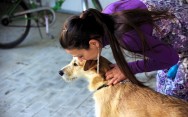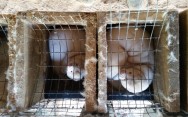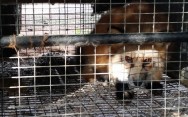Blog Archives
Home -
Archive by category "Animal rights" (Page 6)
The Taji dolphin hunt is one of the most notorious animal slaughters around the world. Every year animal activists look on in horror and helplessness while entire pods of dolphins are lured into coves in the town of Taji in Japan and slaughtered wholesale. These dolphin families are wiped out in front of each other in the name of local tradition. Other dolphins are rounded up and captured and sold for thousands of dollars to aquariums in China that aren’t compliant with world standards on captive animals. The 2009 movie “The Cove” was made to expose this terrible slaughter and the world’s helplessness to stop it. Ten years later it is still going on.
The film-makers filmed fishermen luring the dolphins into the cove and killing them by stabbing them with knives. Yet the killings somehow still persist. Fishermen and officials claim the killings are now humane. The actual reality of the killings though, are far from this. According to this description, this is how the dolphins die:
“A metal rod is repeatedly stabbed into the back of the dolphin’s neck and a wooden plug is inserted into the open wound to prevent blood loss. This means the dolphins die a slow, painful death, taking several minutes to bleed out or drown in their own blood.” [https://www.theguardian.com/world/2019/feb/13/taiji-dolphin-hunt-activists-to-launch-unprecedented-legal-challenge]
Mere words cannot begin to describe the horror of this slaughter. Close family units of dolphin pods are killed in front of each other in pitifully cruel ways. Some dolphins who don’t die are released and die of their injuries in the wild. Other “perfect specimens” are sold for thousands of dollars to theme parks. It’s difficult to imagine the despair of seeing your whole family killed and then having to live out your life in captivity and isolation. The town of Taji still clings on to its 400 year “tradition” of whaling. The town is so attached to these traditions that the local whale museum has backed away from International agreements among zoos and aquariums not to display captive animals.
Despite the obvious scientific fact that dolphins are mammals, not fish, they are legally classified as fish in Japan, which means they can’t be protected by cruelty laws. The fishermen and town of Taji have a choice to step away from the killing, but as they are legally free to keep hunting dolphins, the killing goes on. Activists are attacking the cruelty by bringing a lawsuit based on the fishermen exceeding quotas and the dolphins’ status as mammals rather than fish.
When we see what humans do to animals we truly enter the realm of the arbitrary. Laws segmenting the animal kingdom into those that can be harmed and those that can’t; brutal “traditions” that humans cling to when it’s no longer a matter of survival; the right to treat animals as chattels and kill and torture them. Killing animals exposes us to the side of our nature that is violent and irrational. In the case of the ritualized Taji killings, we have to look unflinchingly at these practices, but also beyond them. Animal captivity for example, is not a harmless counterpoint to eating animals, it is part of the system that gives animals value as “things” rather than independent beings:
“People need to understand that if they’re planning a vacation down to Mexico and they want to swim with dolphins in captivity, they’re encouraging this behavior and this hunting season to continue.” [https://www.washingtonpost.com/world/2019/10/14/japans-dolphin-hunt-struggle-between-local-traditions-global-anger/]
The killings of Taji should throw a harsh light on the irrationality and cruelty of tradition for its own sake. Any value system in which animals and our fellow humans have a use value to us rather than independent sovereignty of their own, will inevitably become abusive. The killing grounds of the Taji waters are not an outlandish annual event, they are the ritualized nature of violence laid bare.
Read More:
https://www.theguardian.com/world/2019/feb/13/taiji-dolphin-hunt-activists-to-launch-unprecedented-legal-challenge
https://www.washingtonpost.com/world/2019/10/14/japans-dolphin-hunt-struggle-between-local-traditions-global-anger/
Australia’s Capital Territory has just taken an important leap forward in the legal treatment of animals. The new laws in Australia’s Capital Territory recognize that animals can perceive and feel the world around them and have “intrinsic value.” These concepts finally depart from the legal structures which incarcerate animals as objects designed for humans’ use and abuse, and which characterize most legal systems around the world.
The laws impose sizeable fines and prison sentences for confining animals, lack of animal care and participating in cruelty to animals. They also move to restrict pet shops and the pet shop industry.
There is reason to celebrate the passing of these laws, but a good beginning mustn’t be a permanent band-aid. This article is right to point out that “animal sentience” does more to regulate treatment of pets than it does to change humans’ relationship with animals. Australian industries that harm animals won’t be expected to change. A “duty of care” is imposed on humans when they are in a relationship of care. But so many of human relations with animals are mediated through profit and product, rather than care. The new laws recognize that animals should not be humans’ property in the law. In practice they will defend the animals humans have chosen as pets, abandoning the animals victimized by industry. We can only hope that the interpretation of these laws and further activism will expand protection to animals who are still being brutalized.
Read More:
https://www.canberratimes.com.au/story/6407314/act-passes-australia-first-animal-sentience-laws/
In an ideal world, mourning the death of any living being should not bring relief for their passing. When death brings relief because a being has been suffering unimaginably however, we are glad the suffering has passed out of the world, at least. Often, the suffering of any animal comes in the form of pain or illness. In the case of Tikiri, the 70 year old elephant, her suffering was a result of years’ of slavery and abuse. The 70 year old Tikiri the elephant came to the world’s attention due to her emaciated appearance at a religious festival in Sri Lanka. The animal was used in a parade for 10 days each year. She was photographed in a skeletal, emaciated state, apparently malnourished and exhausted by her job. The elephant would march for days at this festival while hungry, exhausted and at an advanced age. Her body was covered with decorations to hide her terrible condition. Tikiri had been a working animal all her life, and was forced to march, despite being “India’s oldest elephant.”
It’s easy to forget that “fun elephant rides” for tourists are the other face of animal slavery. If tourists and those attending religious festivals boycott attractions and entertainments based on elephant slavery, unnecessary suffering could be prevented. That way, Tikiri’s suffering could at least lead to some kind of justice for others’ like her.
https://www.cnn.com/2019/09/25/asia/emaciated-elephant-death-sri-lanka-scli-intl/index.html
This Vice headline sums the Amazon situation up with the kind of bluntness that’s needed at the moment: “Sad About the Amazon Fires? Stop Eating Meat.” The article is a timely correction to the assumption that logging is the reason we are losing the Amazon rainforests. Many posting on social media accounts about the Amazon fires are unthinkingly connecting the damage to “other people”: greedy logging companies etc., when in fact the trail leads directly back to the people posting – many of whom eat meat. Cattle ranching is the leading cause of deforestation in the Amazon, and clearing lands to make way for cattle is what is causing the fires.
The growing demand for meat is driving this destruction, in particular the demand for beef. With plenty of healthy protein substitutes available, the slaughter of cattle is completely unnecessary. Industrial farming harms the environment in other ways through water pollution from slaughterhouses. Animal suffering is an inevitable byproduct of treating animals like products, to be mutilated and packaged. In the tragedy of the Amazon rainforest we can see how this approach to life has outward ripples. When we treat life like an industrial product, when we kill animals brutally, we lack the respect for other life that is ultimately needed to save our own lives and habitats.
Read More:
https://www.vice.com/en_in/article/bjwzk4/feeling-sad-about-the-amazon-fires-stop-eating-meat
by Dr. Kevin Boileau
In Santics v. Vancouver (City) Animal Control Officer, 2019 BCCA 294, The appellant’s dog was designated a dangerous dog after it seriously injured a person in a public park. The Provincial Court judge who heard the matter assumed the availability of conditional orders falling short of destruction in dangerous dog proceedings under s. 324.1 of the Vancouver Charter, but held that the lack of reasonable alternatives for the dog’s rehabilitation meant that there was no choice but to order destruction. The judge’s decision was upheld by the Supreme Court of British Columbia on appeal. The appellant appeals from the order of the Supreme Court. Held: Appeal dismissed. On the evidence, it was open to the Provincial Court judge to conclude that the appellant’s dog posed an unacceptable risk to the public and ought to be destroyed. Furthermore, on an application by an animal control officer to the Provincial Court for a destruction order pursuant to s. 324.1(10) of the Vancouver Charter or s. 49(10) of the Community Charter, the Provincial Court, upon finding that the dog is dangerous in that it poses an unacceptable risk to the public, does not have the jurisdiction to make a conditional order falling short of the dangerous dog’s destruction; the dog must be ordered to be destroyed. The Provincial Court does, however, have the jurisdiction to conclude that the dog does not pose an unacceptable risk to the public, in that the dog is not likely to kill or seriously injure in the future, whereupon the dog is to be returned to its owner.
The Honourable Mr. Justice Abrioux states as follows, in the court record:
I: INTRODUCTION
[1] This appeal marks the first opportunity for this court to substantively address the dangerous dog provisions of the Vancouver Charter, S.B.C. 1953, c. 55, and identical provisions contained in the Community Charter, S.B.C. 2003, c. 26.
[2] In an order dated January 10, 2019, the Supreme Court of British Columbia dismissed an appeal brought by the appellant, Ms. Susan Santics, from an order of the Provincial Court of British Columbia requiring the destruction of her dog. Ms. Santics appeals to this court from the order of the Supreme Court.
[3] This appeal concerns not only the fate of “Punky” — a four-year-old Australian cattle dog owned by Ms. Santics and which seriously injured a woman in a public park — but also raises questions as to the Provincial Court’s powers on an application for the destruction of a dangerous dog. In particular, it raises the question of whether s. 324.1(10) of the Vancouver Charter and s. 49(10) of the Community Charter confer jurisdiction on the Provincial Court to make conditional orders falling short of destruction.
[4] This appeal also raises the correctness of Capital Regional District v. Kuo, 2006 BCSC 1282 (“Kuo”). For 13 years, Kuo has been relied on by both the Provincial Court and the Supreme Court — the latter in its role as an appeal court — as the authority for the Provincial Court’s jurisdiction to make conditional orders falling short of destruction in dangerous dog proceedings: see, for example, Panton v. Central Okanagan (Regional District), 2016 BCSC 69.
[5] I would conclude as follows:
(a) in so far as Ms. Santics’ dog is concerned, the Supreme Court judge committed no reviewable error in dismissing the appeal from the Provincial Court’s order that the dog be destroyed;
(b) contrary to the reasoning in Kuo, once the Provincial Court has found that a dog is likely to kill or seriously injure within the meaning of the Vancouver Charter or the Community Charter, it does not have the jurisdiction to make orders — conditional or otherwise — save for that the dog in question be destroyed;
(c) notwithstanding (b), there may be circumstances in which a dog that satisfies the statutory definition of “dangerous dog” nonetheless does not pose an unacceptable risk to the public, in which event the Provincial Court must dismiss the destruction application and release the dog to its owner; and,
(d) while there may well be good policy reasons for recognizing conditional orders in certain situations, as legislation in some Canadian provinces has done, it is for the Legislature and not this court to determine the framework that ought to apply in British Columbia.
(e) I would accordingly dismiss the appeal.
There is more to the complete record, but let’s focus on the summary above, which demonstrates serious lack of due process and a serious lack of regard for the life of a dog. The Appellate decision on its face is violent and irrational because it won’t give the provincial court authority to weigh middle-ground options including rehabilitation, and transfer of custodianship out of the city. In the U.S. this could be viewed as a serious due process issue, especially because of the legal trend to recognize that domestic dogs have interests. Even the language of the vicious dog statute is suspect because one option is to “destroy” the dog. To destroy is something you do to things not living beings. Even death row human inmates are not destroyed, they are executed. Thus beyond the fact that this judge just overturned several years’ of common law, the actually vicious dog law would apparently be in conflict with the trend in the law to recognize interests if not some rights of domestic dogs.
Second, whatever harm happened was due to the negligence of this dog’s custodian and yet the Canadian court system chooses to make the dog responsible. This dog should never have been in the city. He is a cattle dog and should be out in the country. Currently he is being held in impound, which is further harm to him. The dog is a victim here, not a perpetrator.
Third, because this dog’s very life is at stake, the Appellate Court justice and the Provincial court erred in allowing the dog’s custodian to represent herself and her dog’s interest. At a very minimum this custodian should have been represented by counsel. The court should have also required that the dog be represented by separate legal counsel when his very liv eis at stake. Obviously, the court recognizes the need for some due process requirements in vicious dog adjudications. It seems logical that it would recognize the interests of the dog, especially in a capital case like this.
Fourth, the provincial court erred in not allowing the development of evidence that this dog could be rehabilitated. Now, the Appellate Court makes the specious argument that the dog has not been rehabilitated in its two years’ imprisonment, but this very imprisonment was caused by the government. Thus, the government cannot make the unpersuasive argument that the dog’s custodian took no measures to rehabilitate the dog while it has been imprisoned. There has been little to no evidence adduced about sending the dog out of the city, and into the hands of a certified sanctuary in North America, where the dog could be rehabilitated, placed in a new and safer environment away from the congestion of people in a city park. The Appellate Court has clearly erred in its conclusion that there is no evidence that the dog is an acceptable risk to the public. The Provincial Court makes the same error.
In short, this is a tragic case of A) a dog being in the wrong environment for its breed and temperament and B) needing a different sort of human custodian. Perhaps if Punky’s owner transferred his ownership to a rehabilitation expert, a sanctuary, or some other kind of certified organization that was far out of the jurisdiction and far away from the city, the court would find that this would insure an “acceptable level of risk to the public.”
If the Supreme Court of Canada hears this case, it ought to send it back to the provincial court with instructions that insure due process and prevent the further harm of the canine victim, Punky.
by Dr. Kevin Boileau – Psychoanalyst and Lawyer-Mediator
There are at least three non-violent solutions that would better than the MCIRVIN RANCH returning again and again to kill members of the Profanity Wolf Pack in the northeastern part of the state. Yet, Washington State officials continue to side with the violent destruction of an endangered species while weak-minded Wolf Advisory members look on, watch, and agree. We find the actions of the state and the Wolf Advisory Committee to be both morally unjustified and intellectually specious.
The gray wolves are protected by the Endangered Species Act. The Profanity Pack lives in one of the most remote regions of the United States. These wolves don’t bother any humans except for one family. This is the MCIRVIN ranching family in Eastern Washington who rents OUR PUBLIC LAND for cattle grazing in order to increase its profits. Because the wolf pack has apparently attacked the cattle, and because the Wolf Advisory Committee has foolishly created a murder protocol, men from U.S. Wildlife Services obtain a license to exterminate this wolf pack instead of seeking rational and non-violent solutions.
There is much debate about how to prevent wolves from killing livestock. PhD-level researchers with non-violent solutions were hushed up by state officials. Others have suggested moving cattle from the public lands. Yet, because wolves do not enjoy ontological parity with humans, if humans’ interests are a factor, federal protections don’t defend the wolves from being killed. When the interests of humans and animals differ, humans will always win in the end — even though wolves are protected under the Endangered Species Act. Because every aspect of the planet is commodified under capitalism, the wolves are assigned a value less than that of a ranching family’s interests in money. Because the ranch has rented out PUBLIC LANDS, their interest is valued more than the wolves’ interest in remaining alive.
Conservation groups on the Wolf Advisory Board are so grateful to be allowed a voice at the table with the state authority and with ranching money that they are afraid to take a truly protective stance for wolves. There are many public Internet entries proclaiming how “tragic” this is and how sad the individuals are on behalf of the wolves, but there is but no real advocacy and solidarity. It is disappointing that such a weak group of people is in charge of making these important decisions. In contrast, the rancher is simply providing slaughtered meat to citizens with an addiction for it, even though climate science strongly warns against this polluting, immoral enterprise.
Anyone who was involved in drafting this kill protocol, anyone who continues to order the wolf genocide, or carry these orders out, should be deeply ashamed of themselves. They demonstrate neither intelligence nor moral consciousness. Either directly or by complicit passivity they represent the violence in humanity, and the lack of regard for other sentient beings. It shows a lack creative problem-solving skills or worse yet, allowing ourselves to become inebriated by “bureau-speak.”
The three non-violent options are to collar the cows, move the cows and pay the rancher money, or rescue and transport these wolves. In addition, there are at least three truths of the matter. First, there is no other place for the wolves to go than where they are. Second, the pups are just as innocent as the puppy you brought home for your children. Third, it is still an option to re-locate the remaining wolves. We are betting that the Wolf Advisory Board remains passive and that the scurrilous demagogues in Olympia maintain their murderous, violent, vile campaign. Why? The public wants to know.
There is a qualitative difference in how we talk about animal vs. human abuse. That also translates into how we punish animal abuse. A man from Missouri has been released into house arrest after he tortured and killed at least 12 cats that he brought from craigslist for the specific purpose of killing and torturing them. The man revealed that he enjoyed stamping on the heads of cats and killing them by strangling them. He seemed to enjoy victimizing a wide variety of cats. He used craigslist to obtain mother cats, baby kittens and adult cats. Craigslist was this man’s a la carte menu of victims, a way he could easily gain access to a variety of animal victims to appease his violent appetites.
The man is considered a violent animal abuser and faces felony animal abuse charges. This pattern of killing and abuse seems deeply ingrained, to the extent that he will probably always be a danger to animals, and even humans. There is a petition urging the St. Charles County prosecuting attorney to prosecute the man to the fullest extent of the law and require extensive psychological intervention. If this man had abused and killed humans, he would be considered a dangerous serial killer. Unlike with a serial killer, however, this animal murderer will be free in the future to hurt animals and humans too. The max sentence for animal cruelty rarely stretches beyond five years. Several studies and the FBI have found a correlation between animal cruelty and the crimes of serial killers and rapists. Animal cruelty still ranks below cruelty to humans even though it is an equivalent violent crime, as perpetrators harm humans too.
The other side of this issue is that craigslist is effectively allowing animals to be trafficked by allowing them to be listed on their website without protections. There’s no guarantee that animals listed through craigslist will go to a good home. The fact that animals can be listed on craigslist indicates how low animal life is valued in the first place. Serial killers and abusers can obtain animals like they are property (as they’re considered by the law), and treat them like objects to be defiled. The ease with which this animal serial killer could torture and kill animals shows how much work there is to be done on the issue of sheltering animals from abuse and taking animal abuse seriously as the horrific violence that it is.
Read more about this issue, share the petition, and read about why you should never list animals on craigslist.
https://en.wikipedia.org/wiki/Cruelty_to_animals
https://www.humanesociety.org/sites/default/files/docs/state-animal-cruelty-chart.pdf
https://www.thoughtco.com/dont-give-pets-away-free-127759
There is a lesson the public has learned from recent videos of cows being violently abused on Martin’s Farms, and it’s not what you think it might be. The videos of cows are an awful spectacle that has caused Martin’s Farms to fire employees in a show of remorse and responsibility. The real lesson however is that accountability for animals’ suffering is based on the martyrdom of animals rather than concern for them. The lesson is that animals have to be hurt and to suffer before action is taken. There’s a reason for this: many dairy farms throughout the US are inspected by milk co-ops, i.e. the dairy industry itself. Farms overseen by the Maryland and Virginia Milk Co-Op (including Martin’s Farm in Pennsylvania), don’t even make inspections public record. Is it any wonder that action is only taken when it’s too late, since the dairy industry has no incentive to prevent or stop abuse? Firing workers and apologizing is not the same as systematic change and it won’t take back the suffering of the animals.
Let’s return to what happened to the dairy cows at Martin’s Farms. Cows at Martin’s Farms were punched kicked, stomped on, blasted with scalding water to make them move. An operation was performed on a cow without anesthetic. Another cow was shot with a bullet in a botched, brutal killing and then shot a second time when it didn’t work. It’s easy for humans to rest comfortably in delusions that make us feel better, that this video showed unusual cruelty, and that justice has now been done. Unfortunately it’s very likely that cruelty like this is happening at other farms, right now, with no oversight. Accountability is one thing, but that can only happen with care, concern and oversight. For animal suffering to be prevented, humans need to stop indulging in outrage and “justice” and start protecting animals over industry. Please read, share and take action:
https://forcechange.com/530234/dairy-cows-reportedly-tortured-and-abused-deserve-justice/
https://wjla.com/features/7-on-your-side/inspecting-animal-welfare-on-dairy-farms
This film is a very good example of [Christian] humanistic beliefs about the nature of human beings, and the deep ontological assumption of ontological [dis]parity. In this way of thinking we see hierarchies everywhere, with only the bishops, the Pope, angels and God outstripping the value of humans, and people of some color and gender of greater value than others. Most people cannot see a new Archimedean point of view, in which this “worlding” is replaced by one with a much more justifiable moral construction. In this film, we see dolphin families destroyed, their members vocalizing terror, puzzlement, and and deep grief. Some of the dolphins are hauled to the pier and chopped to pieces as they lie dying. Others are sold to Russian and Chinese aquariums, forever imprisoned until they die. There is nothing about this practice that is morally redeeming and, in the converse, it shows how little evolved humanity is. You should also know that Japanese “scientists” have been regularly capturing Antarctic whales for the purpose of “knowledge” when, in fact, they are taken as food.
This practice is analogous to others, in which we use animals for entertainment, clothing, food, “research,” and sexual gratification in ways that are demeaning, abusive, harmful, torturous, sadistic, and vile. Some people argue that it is our “natural” right but this is another deception by fiat. The truth is that we are a violent species, narcissistic, “speciesist”, egocentric, and capable of generating outlandish arguments that purport to serve our best interests–that our best interests always outweigh the interests of the Other. We have this way of thinking within the human population as well, as I mentioned before: power underwrites knowledge, truth and morality. Yet, we colonize other races, and colonize other species in exactly the same way with the same kind of thinking.
When we truly excavate our thinking, we always find the hidden treasure – the deep assumption – that we believe we are of greater ontological worth and value than individuals of other species. We do it with lions and tigers, wolves and bears, domestic dogs and cats, marine life, and the rest of them. “Tolerance”, moral relativism, and moral subjectivism were the worst–and least plausible philosophical positions ever proffered, for they operated as defenses against some of the most atrocious behavior we have seen. Unfortunately, tolerance is the sign of a weak person and a weak culture. It is one of the greatest deceptions ever. We must not be tolerant. Instead, we must use our reason to think–critically–about our behavior, and someone else’s. This does not mean we ought to opt for vicious objectivisms either, for they are on the other wrong side, and have as their bulwark the psychopathology of capitalism, complacence, the dangers of [Zizekian] hysteria, and claims to truth that are always underwritten by power.
Thus, this film can enlighten us to our savage Japanese cousins, but hopefully wake us up to our own “peccadilloes.” Shooting coyotes to make fancy runway Canada Goose jackets for the rich; shooting grizzly bears from fear; setting bait for wolves [near Stevensville] laced with broken glass and strychnine]; injecting primates with Ebola viruses in the lab at Hamilton; forcing elephants to give you a a circus ride, or tigers to jump through fire or be beaten; fucking dogs that have been forced into prostitution; setting cats on fire; engaging in absolutely irrational animal-model research then often usually killing and throwing the subjects into the garbage; imprisoning cows, raping them, preventing their young from suckling, then selling cheese, milk, and ice cream cones to the hoi polloi while we murder males for veal and start raping the females all over again; racing horses then herding them into the Killbox for their “meat; finding “humane” ways of raising cattle and slaughtering them to the tune of decades of poisoned water, noxious carbon and methane, and workers who suffer almost 100% PTSD for being the agents of violence.
The Anthropocene. What gets me is that some folks who are hailed as brilliant geniuses in this ontological order show up as as imbeciles in another. Moreover, even though the fallacy of the false dichotomy, the fallacy of oversimplification, and the either-or fallacy ought to be avoided, we must also avoid their dark cousin, the fallacy of obfuscation, in which we intellectuals hide inside words without fully participating in our “god-given” interrelational self, which requires us to overcome the false belief that we are at the center of anything, the masters of anything including discourse, and that from universities spring truth and goodness.
The most difficult task for any of us to is to see the Other – the radical Other – outside of our own mental categories to which we cling like children. And thus, without poiesis we will continue to be lost at sea, just like these dolphins who are slaughtered because they “belong” to us – another fallacy. The only enjoyment I get is knowing that humans will “get theirs.” This is natural justice, a deep algorithm that underwrites true natural rights.
The Cove: https://www.imdb.com/title/tt1313104/
Let’s imagine that humans meet a superior species – stronger, smarter, and more vile than we are. They chain us, train us, experiment on us. They force us to entertain them, and they hold us captive for rape. They hunt us, trap us, and take pictures of us when we have been “harvested.” They cut us into pieces, tear our skin from us, throw us into boiling water, and make words about ecosystems, wildlife management, and the “natural” way of things. Then we will finally ponder ontological parity, virtue, empathy – making all sorts of “moral” claims about justice and fairness. In response, some won’t care, some will cut with greater precision, some will ignore us, and others will laugh, sadistically. Our bourgeois universities will “smoke” their books with more intensity until they, too, perish in the Great Annhilation – the New Holocaust. Then, there will be others who awake to the truth of things and realize that our dream of fertility, Western expansion, colonialisms, violence, and eugenics is truly what we have known all alone – a National Socialist nightmare that is coming to your door.








Social Media